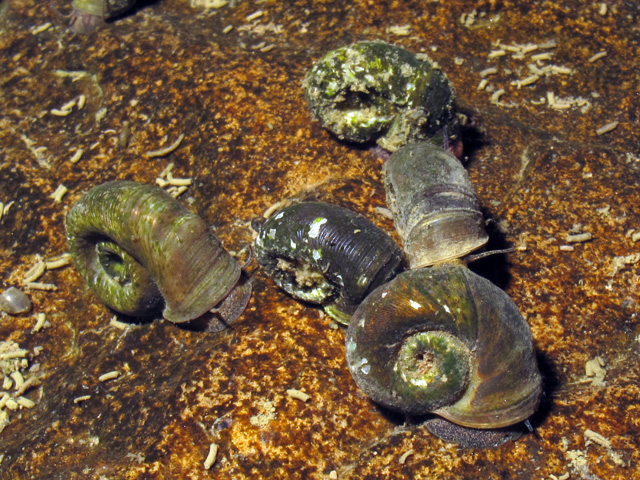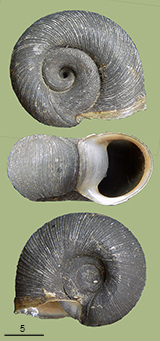> Habitat & Distribution
Helisoma trivolvis ranges throughout North America, from arctic Canada to Florida, westward across our entire 21-state study area, although confusion with the (very similar) H. scalaris duryi is likely at the southern limit of its range. Populations are not well adapted to lotic waters, such as prevail in the Blue Ridge, Central Appalachian, or Western Allegheny plateau ecoregions, for example, nor are they found in especially acidic waters. But elsewhere, populations are common in lakes, ponds, swamps, and calm riverine backwaters, especially in rich, eutrophic environments. FWGNA incidence rank I-5.
> Ecology & Life History
Helisoma trivolvis populations often demonstrate a weedy or pioneering habit in the wild (Eversole 1978). Laboratory populations can mature with as little as three months in culture, laying perhaps 20 - 40 eggs per week thereafter, depending on culture conditions (van der Schalie & Berry 1973, Norton et al. 2018a). See my essay of 9Sept20 from the link below for photos of the peculiar-looking juvenile shell morphology.
Outcrossing is preferred but self-fertilization is possible (Paraense & Correa 1988). The data on reproductive energetics developed by Eversole (1978) suggested to Dillon (2000: 126 136) that a New York population of H. trivolvis might be R-adapted with respect to USR life history theory, displaying a reproductive effort over an order of magnitude greater than predicted from body size.
Jokinen s (1987) analysis of the distribution of H. trivolvis in Connecticut and New York led her to classify it as a C-D tramp, potentially present in nearly every community. Dillon s (2000: 360-363) reanalysis of these data showed H. trivolvis especially common in rich but unpredictable environments, again consistent with the hypothesis of R-adaptation.
The bulbous, planispiral shell of H. trivolvis typically enfolds a large pocket of air, rendering it positively buoyant, and thus it is commonly found among floating vegetation. Helisoma trivolvis seems to have a stronger trophic apparatus than most freshwater snails; able to ingest macrophyte tissue and thriving on lettuce, as well as grazing rather nonspecifically on the periphyton (Smith 1989 a & b, Lombardo & Cooke 2002). The laboratory experiments of Sura & Mahon (2011) suggested that H. trivolvis increases its feeding rate in the presence of the potential competitor Bellamya chinensis, and decreases feeding in response to the presence of crayfish.
Predators of H. trivolvis include leeches (Klemm 1975, Dillon 2000:303-304) and crayfish (Alexander & Covich 1991b, Dorn 2013). It has played the white rat in several studies of community ecology (Boerger 1975, Brown 1982).
Helisoma trivolvis has served as a model organism for neurobiological studies (Bulloch & Ridgway 1989, Cole et al. 2002, Geddis & Rehder 2003), and its hemoglobin has attracted the attention of physiologists (Herskovits & Hamilton 1994). It hosts a variety of trematode parasites (Sapp & Loker 2000, Fried & LaTerra 2002), including the worm that has recently become a pest in commercial catfish ponds (Venable, Gaude & Klerks 2000).
> Taxonomy & Systematics
Ecophenotypic plasticity has led to a proliferation of synonyms in wide-ranging H. trivolvis populations, including: ammon, binnyi, corpulentum, intertextum, pilsbryi, subcrenatum, tenue, and truncatum.
There has also been considerable confusion regarding the distinction between Helisoma trivolvis and H. scalare, especially in its planispiral, duryi form. The shells of juvenile H. trivolvis are marked with threadlike spiral striations and (typically) an acute apical keel, while those of juvenile H. scalare are much smoother and glossier, lacking both features. See my essays of 3Dec21, 5Jan21, and 9Feb21 from the links below for more.
Baker (1945) placed trivolvis in the subgenus Pierosoma, which Burch (following Taylor 1966) subsumed under Baker's subgenus Planorbella and promoted to genus rank. But we agree with Hubendick (1955) that the relatively minor attribute of shell coiling apparently the basis for this move does not warrant reacognition of Planorbella at the generic level. See my essay of 11Apr08 from the link below for more.
> Maps and Supplementary Resources
- Helisoma distribution in the drainage of The Ohio (2019)
- Helisoma trivolvis distribution in Atlantic drainages (2023)
- Helisoma distribution in Georgia and the Florida panhandle (2025)
- Helisoma distribution in the Tennessee/Cumberland (2022)
- Helisoma distribution in The Great Plains (2024)
- Helisoma trivolvis in a New River pool, courtesy of Alan Cressler.

- Pretty photo of living H. trivolvis courtesy of Chris Lukhaup.
> Essays
- See my post to the FWGNA blog of 11Apr08 for a review of the Classification of the Planorbidae.
- Or view the (Hubendick 1955) classification of North American planorbids in a tabular format [here].
- See my post of 26Sept14 for good, comparative figures illustrating "The egg masses of freshwater pulmonate snails."
- The peculiar shell morphology demonstrated by juvenile H. trivolvis was reviewed in my lavishly-illustrated essay of 9Sept90, Juvenile Helisoma.
- See my essays of 3Dec20 (The Emperor Speaks), 5Jan21 (Collected in Turn One) and 9Feb21 (The Emperor, the Non-child, and the Not-short Duct) for a detailed account of my personal journey toward distinguishing Helisoma trivolvis from the Floridian Helisoma scalare duryi. All three of these essays are lavishly illustrated with with figures of anatomy, shell morphology, and habitat.
> References
Baker, F. C. (1945) The Molluscan Family Planorbidae. Urbana: University of Illinois Press.
Baker, H. B. (1946) Index to F. C. Baker's "The Molluscan Family Planorbidae." Nautilus, 59, 127-41.
Boerger, H. (1975) A comparison of the life cycles, reproductive ecologies, and size-weight relationships of Helisoma anceps, H. campanulatum, and H. trivolvis (Gastropoda, Planorbidae). Can. J. Zool. 53: 1812-1824. 1975.
Brown, K.M. (1982) Resource overlap and competition in pond snails: An experimental analysis. Ecology: 63: 412-422.
Burch, J. B. (1989) North American Freshwater Snails. Malacological Publications, Hamburg, MI. 365 pp.
Bulloch, A.G.M. & Ridgway, R.L. (1989) Neuronal plasticity in the adult invertebrate nervous system. J. Neurobiol. 20: 295-311.
Cole, A.G., Mashkournia, A., Parries, S.C. & Goldberg, J.I. (2002) Regulation of early embryonic behavior by nitric oxide in the pond snail Helisoma trivolvis. J. Exp. Biol. 205: 3143-3152.
Dillon, R. T., Jr. (2000) The Ecology of Freshwater Molluscs. Cambridge University Press, Cambridge, England. 509 pp.
Dorn, N. J. (2013) Consumptive effects of crayfish limit snail populations. Freshwater Science 32: 1298 - 1308.
Eversole, A. (1978) Life cycles, growth and population bioenergetics of the snail, Helisoma trivolvis (Say). J. Moll. Stud., 44: 209-222.
Fried, B. & LaTerra, R. (2002) In vitro and in vivo encystment of the cercariae of Echinostoma caproni. J. Parasitol. 88: 1124-1129.
Geddis, M.S. & Rehder, V. (2003) Initial stages of neural regeneration in Helisoma trivolvis are dependent upon PLA sub(2) activity. J. Neurobiol. 54: 555-565.
Herskovits, T.T. & Hamilton, M.G. (1994) The molecular weight and subunit organization of Helisoma trivolvis (Say) hemoglobin: Light-scattering and scanning transmission electron microscopic studies. Comp. Biochem. Physiol. 107B: 433-441.
Hubendick, B. (1955) Phylogeny in the Planorbidae. Trans. Zool. Soc. London 28: 453-542.
Jokinen, E. (1987) Structure of freshwater snail communities: Species-area relationships and incidence categories. Amer. Malac. Bull. 5: 9 - 19.
Lombardo, P & Cooke, G. D. (2002) Consumption and preference of selected food types by two freshwater gastropod species. Arch. Hydrobiol. 155: 667-685.
Mancia, M.R. & Fried, B. ( 1995) Chemoattraction and dietary preferences of Helisoma trivolvis (Gastropoda: Planorbidae) for leaf lettuce and Tetramin. Veliger 38: 73-75.
Morris, J.R. & Boag, D.A. (1982) On the dispersion, population structure, and life history of a basommatophoran snail, Helisoma trivolvis, in central Alberta. Can. J. Zool. 60: 2931-2940.
Norton, C.G., A.F. Johnson & B.N. Nelson (2018a) Population differences in fecundity components in the hermaphroditic freshwater snail Planorbella trivolvis. American Malacological Bulletin 36: 23 - 30.
Norton, C.G., A.F. Johnson & B.N. Nelson (2018b) The genetic basis of albinism in the hermaphroditic freshwater snail Planorbella trivolvis. American Malacological Bulletin 36: 153-157.
Paraense, W.L. & Correa, L.R. (1988) Self-fertilization in the freshwater snails Helisoma duryi and Helisoma trivolvis. Mem. Inst. Oswaldo Cruz. 83: 405-409.
Rowan, W. (1966) Autumn migration of Helisoma trivolis in Montana. Nautilus 79: 108-109.
Sapp, K.K. & Loker, E.S. (2000) Mechanisms underlying digenean-snail specificity: Role of miracidial attachment and host plasma factors. J. Parasitol. 86: 1012-1019.
Smith, D. (1989a) Tests of feeding selectivity in Helisoma trivolvis (Gastropoda: Pulmonata). Trans. Am. Micros. Soc. 108: 394-402.
Smith, D. (1989b) Radula-tooth biometry in Helisoma trivolis (Gastropoda, Pulmonata): interpopulation variation and the question of adaptive significance. Can. J. Zool. 67: 1960-1965.
Stahl, T. & Lodge, D.M. (1990) Effect of experimentally induced shell damage on mortality, reproduction and growth in Helisoma trivolvis (Say, 1816). Nautilus 104: 92-95.
Sura, S.A., and H.K. Mahon (2011) Effects of competition and predation on the feeding rate of the freshwater snail, Helisoma trivolvis. American Midland Naturalist 166(2):358-368.
Taylor, D. W. (1966) Summary of North American Blancan nonmarine mollusks. Malacologia 4: 1 - 172.
van der Schalie, H., & E. Berry (1973) The effects of temperature on growth and reproduction of aquatic snails. Sterkiana, 50: 1-92.
Venable, D.L., Gaude, A.P. III, & Klerks, P.L. (2000) Control of the trematode Bolbophorus confusus in Channel Catfish Ictalurus punctatus ponds using salinity manipulation and polyculture with Black Carp Mylopharyngodon piceus. J. World Aquacult. Soc. 31: 158-166.








